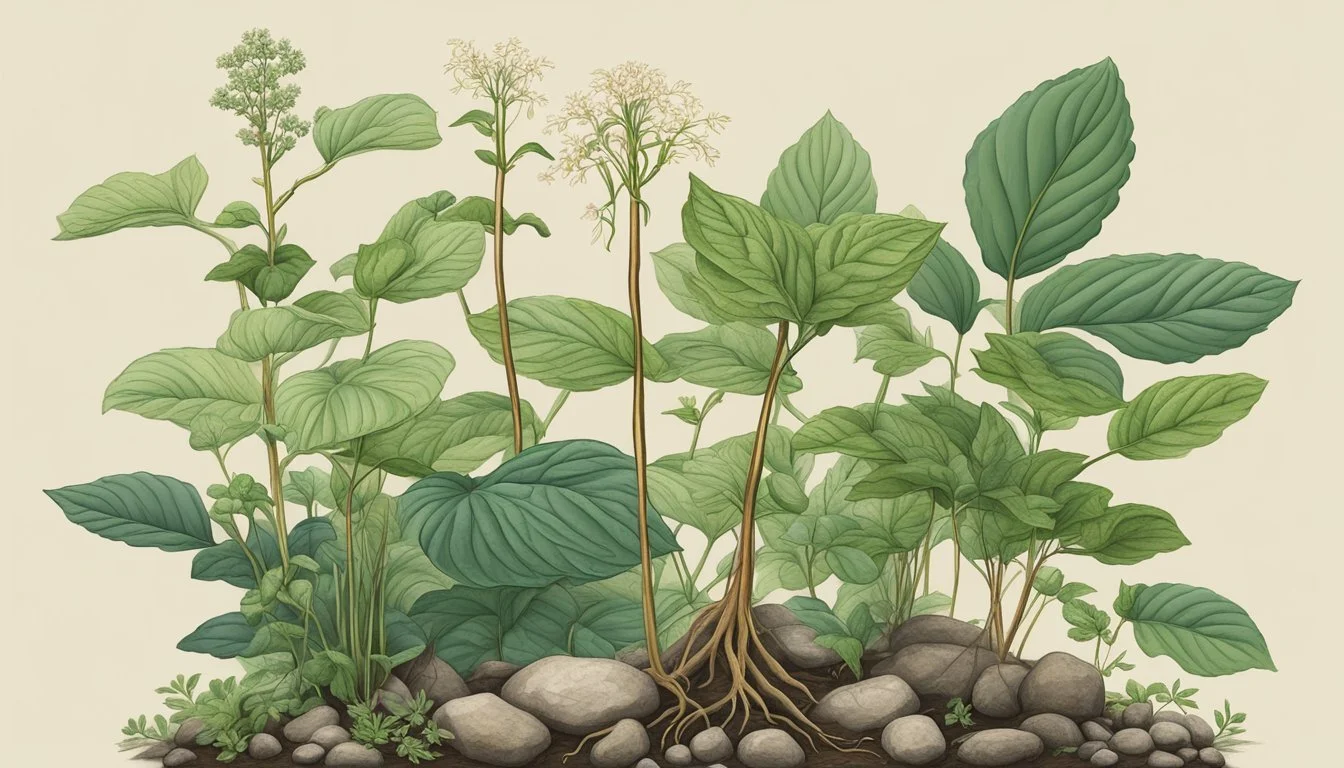Ginseng in Traditional Chinese Medicine
A Vitalizing Herbal Legacy
Ginseng, derived from the root of plants in the genus Panax, stands as a cornerstone in Traditional Chinese Medicine (TCM), revered for its purported restorative and health-promoting benefits. Within the TCM framework, it's seen as a potent tonic that can invigorate the spleen, enhance stomach function, and aid digestion. Known for its distinct character, marked by the presence of natural compounds such as ginsenosides and gintonin, ginseng has been an integral part of health practices in China, Korea, and other regions where its use spans centuries.
Scientifically recognized as Panax ginseng, among other species, this herb earns its name from the Greek words 'pan' (all) and 'akos' (cure), implying its wide-ranging therapeutic attributes. Not just confined to lore, contemporary research has started to unravel how the bioactive components of ginseng might contribute to overall well-being. Its administration has been traditionally tailored to harmonize body functions, with a particular emphasis on enhancing vitality and stamina.
The influence of ginseng extends beyond the medicinal, reaching into cultural spheres where it is valued for both its health benefits and its culinary uses. In TCM, its role is multifaceted, participating in a delicate balance of the body's vital energies, and it continues to be a subject of clinical interest and study in the quest to validate its historical claims with the rigor of modern science.
Ginseng, a revered herb in Traditional Chinese Medicine, has been treasured for centuries for its potential health benefits and holistic healing properties. This esteemed herb has been an integral part of traditional wellness practices, valued for its ability to promote overall well-being. When combined with cinnamon, cranberries, and valerian, ginseng offers a holistic approach to supporting health, reflecting its enduring appeal in ancient and modern wellness traditions.
Furthermore, the addition of shea butter, nuts and seeds, and dates further complements the health-promoting potential of ginseng, contributing to its reputation as a versatile and effective natural remedy. Additionally, the incorporation of rhodiola rosea into wellness practices alongside ginseng has expanded the spectrum of potential health benefits, underscoring the enduring appeal of this remarkable herb.
In conclusion, ginseng continues to be celebrated for its positive impact on health and vitality, offering a natural solution for promoting overall well-being. Whether used in herbal remedies, dietary supplements, or wellness tonics, ginseng remains a symbol of wellness and natural health practices, embodying a rich heritage of traditional wellness and botanical exploration.
Historical Background of Ginseng
Ginseng, cherished for over five millennia in Asia, has woven its way through the tapestry of traditional medicine, becoming an emblem of health and longevity. Its roots extend beyond the confines of herbalism, influencing global trade and cultural outlooks.
Ginseng in Traditional Chinese Medicine
In Traditional Chinese Medicine (TCM), Ginseng (Panax ginseng) is a fundamental herb categorized as a Qi tonic. Its cultivation mainly originated in the regions of China and Korea, where it has long been esteemed for its restorative properties. Historical texts, dating back over two thousand years, detail Ginseng's-prominence in TCM formulas designed to invigorate the spleen and stomach, addressing issues related to digestion and energy levels.
A pivotal TCM formula featuring Ginseng is the renowned sijunzi tang, which consists of the following herbs in synergy:
Ginseng - aids in boosting vital energy (Qi)
Bai zhu (Atractylodis) - supports spleen health and aids in digestion
Fu ling (Poriae) - promotes fluid balance and supports spleen health
Gan cao (licorice) - harmonizes the formula and enhances the effects of other herbs
This comprehensive approach to wellness encapsulates Ginseng's integral role in the holistic perspective of health maintained by traditional practitioners across Asia, including Japan.
Global Trade and Cultural Significance
Ginseng's appeal extends far beyond the boundaries of Asia; it has been a coveted commodity in North America and Europe for centuries. American Ginseng (Panax quinquefolius), in particular, has been subject to rigorous trade due to its high demand in markets around the world. The plant's adoption by various cultures reflects its versatility — each region integrating Ginseng into their own folk medicine practices.
Historically, the recognition of Ginseng's benefits and its subsequent global distribution have forged a unique cultural bridge. Nations not only valued it for its health-enhancing properties but also for its economic worth, thereby earning a place of high regard in the annals of global commerce and cultural exchange.
Botanical Classification
Ginseng is a medicinal plant with a notable classification within the genus Panax, distinguished by its significant therapeutic constituents. The botanical classification of ginseng is pivotal to understanding its varieties and the cultivation methods that impact its quality.
Different Species of Ginseng
The genus Panax consists of several species of ginseng, each with unique properties and native habitats. The most prominent species are:
Asian ginseng (Panax ginseng): Often referred to as Korean ginseng, it is native to East Asia and is a key component in East Asian medicinal practices.
American ginseng (Panax quinquefolius): This species grows in North America and is valued for its cooling properties, in contrast to the warming nature of Asian ginseng.
Wild ginseng: Wild variants of Panax ginseng and Panax quinquefolius are naturally occurring plants that are considered to have higher potency due to the stressors they encounter in their natural environment.
The leaf structure of ginseng varies depending on the species, predominantly displaying palmately compound leaves with variations in margin serration or lobing.
Harvest and Cultivation Techniques
The cultivation and harvest of ginseng are complex processes that directly influence the plant's quality.
Cultivation: Ginseng requires shaded conditions to replicate its natural woodland habitat. The process can be divided as:
Stratification: Seeds undergo a period of cold treatment to promote germination.
Sowing: Seeds are sown either in beds for cultivated ginseng or in forests for semi-wild cultivation.
Harvest: Ginseng roots are ready to harvest between 4 to 6 years after planting. Harvesting techniques include:
Digging the root by hand to ensure minimal damage.
Assessing root quality based on size, shape, and presence of ginsenosides, the plant's active compounds.
Cultivated ginseng can be found in both white ginseng, dried after peeling, and red ginseng, unpeeled and treated with steam.
Through meticulous botanical classification and cultivation, the revered medicinal plant garners its celebrated place in traditional medicine.
Chemical Composition
Ginseng's chemical composition is complex and comprises two main categories: ginsenosides, which are unique to the ginseng plant, and non-saponin components that include a variety of essential nutrients. Here, the focus will be on these chemical constituents and their respective properties and benefits.
Ginsenosides and Their Properties
Ginsenosides are the signature saponins found in ginseng and are central to its therapeutic potential. They possess a dammarane triterpenoid structure and are credited with a plethora of biological activities. The known ginsenosides can be classified into two major groups based on their glycosylation pattern:
Protopanaxadiols: Rb1, Rb2, Rc, Rd.
Protopanaxatriols: Re, Rg1, Rg2, Rh1.
Table: Selected Ginsenosides and Their Potential Effects
Ginsenoside Potential Effect Rb1 Neuroprotective, anti-inflammatory Re Enhances immunity, anti-fatigue Rg1 Cardiovascular protection, anti-aging Rg3 Antitumor, improves circulation
Ginsenosides interact with the body's cells through various mechanisms, such as modulating immune responses, exerting antioxidant properties, and influencing the production of nitric oxide, which plays a critical role in cardiovascular health.
Non-Saponin Components and Essential Nutrients
In addition to ginsenosides, ginseng roots are rich in various non-saponin constituents that contribute significantly to its overall medicinal profile. These include:
Polysaccharides: Known for their immune-enhancing properties.
Peptides: Small chains of amino acids that may have bioactive functions.
Essential Oils: Contribute to ginseng's distinct aroma and may have therapeutic effects.
Amino Acids: Building blocks of proteins, essential for various metabolic processes.
The presence of antioxidants in ginseng helps to neutralize harmful free radicals, while essential oils, amino acids, and peptides play vital roles in the general health-promoting attributes of this traditional root.
By understanding the intricacies of the chemical composition of ginseng, it is possible to appreciate the scientific basis for its longstanding use in traditional medicine, as well as its growing acceptance in modern pharmacology.
Pharmacological Effects
Ginseng is recognized for its broad pharmacological effects on the human body, impacting various systems such as the immune system and the central nervous system, while also exhibiting antioxidant and anti-inflammatory actions that protect against oxidative damage.
Effects on the Immune System
The immune-modulatory properties of ginseng are attributed to its active components, including ginsenosides. These compounds have been shown to enhance the body's resistance against infections and diseases by stimulating immune cell activity. Clinical investigations suggest that ginseng may improve the functioning of natural killer cells and macrophages, thereby potentially increasing the body's defense mechanisms against pathogens.
Impact on the Central Nervous System
Ginseng's influence extends to the central nervous system where it may aid in cognitive performance, memory enhancement, and mood stabilization. Studies have identified that certain ginsenosides can exert a neuroprotective effect, potentially benefiting patients with neurodegenerative disorders. Furthermore, ginseng has been associated with the alleviation of mental fatigue and promoting an overall sense of well-being.
Antioxidant and Anti-inflammatory Actions
Antioxidant: Ginseng's antioxidant capabilities stem from its potential to neutralize harmful free radicals, thereby reducing oxidative stress in tissues. This action is critical in preventing cellular damage and maintaining the health of various organ systems.
Anti-inflammatory: The anti-inflammatory properties of ginseng contribute to its therapeutic effects. Research indicates that ginsenosides may inhibit inflammatory pathways within the body, which can mitigate the symptoms of conditions characterized by chronic inflammation. This includes reducing the production of certain pro-inflammatory cytokines and modulating the body's inflammatory response.
Medicinal Benefits
Ginseng, renowned for its potent properties in Traditional Chinese Medicine, is linked to a variety of health benefits. It is used to improve cognitive function, manage diabetes, aid in cancer treatment, and alleviate stress and fatigue.
Ginseng in Cognitive Enhancement
Ginseng has shown promise for enhancing cognitive abilities. Memory and overall cognitive function may benefit, as several studies indicate improved performance in these areas after ginseng supplementation.
Diabetes and Blood Glucose Regulation
In the context of diabetes, particularly type 2 diabetes, the root may play a role in blood glucose regulation. Ginseng's potential to modulate blood sugar levels is significant for diabetes management.
Cancer Treatment and Prevention
Studies suggest ginseng possesses anticancer properties that might be beneficial in cancer prevention and treatment. It is considered to have a role in reducing the risk of certain types of cancer and may also help alleviate cancer-related fatigue.
Stress and Fatigue Relief
The adaptogenic traits of ginseng can counteract fatigue and stress, by supporting the body's natural balance or qi. Its usage has been associated with increased energy and improved resilience against stress.
Usage and Administration
Ginseng, particularly Panax ginseng, has a rich history and a very specific set of preparations and dosages that ensure its efficacy in Traditional Chinese Medicine (TCM). Understanding these methods is crucial for both practitioners and consumers to harness the full potential of this powerful root.
Preparation of Ginseng Remedies
Ginseng roots are traditionally classified into two main types—white ginseng and red ginseng—based on their processing methods. White ginseng is simply the dried root, while red ginseng undergoes a process of steaming before it is dried, enhancing certain pharmacological properties.
Decoction is a common method for preparing ginseng. This involves simmering the root in water to extract its bioactive compounds, such as ginsenosides and gintonin. The result is a concentrated liquid known as Panax ginseng extract, which can be taken directly or added to other herbal mixtures.
Modern techniques involve advanced extraction methods to produce red ginseng extract, which is believed to have higher levels of active components like RG3 and compound K. These extracts are often available in various forms, including liquids, powders, and capsules.
Dosage and Consumption Practices
The dosage of ginseng can vary greatly depending on the form and intended use. It is critical to adhere to the following guidelines to ensure safety and effectiveness:
Standard Dosage: A typical daily dose of ginseng root ranges between 1 and 2 grams of raw herb. Extracts and other concentrated forms should be taken as directed by a healthcare provider or according to product label instructions. Overdosage can lead to adverse effects and should be avoided.
Consumption Practices: Ginseng can be taken as a tea, consumed in extract form, or ingested as a supplement. Timing may be important, with some practitioners recommending ginseng to be taken in the morning due to its energizing properties. Long-term administration should be monitored, as ginseng is traditionally cycled with breaks to prevent potential side effects and ensure its optimal effect.
Healthcare professionals with knowledge of TCM or herbal pharmacology should be consulted for personalized dosages, especially in the context of therapeutic applications. This ensures that the administration of ginseng is appropriate for the individual's specific health needs.
Safety Profile
Ginseng, as an herbal medicine and dietary supplement, generally holds a good safety profile, but certain considerations must be made. Users should be aware of potential side effects and interactions, and weigh these risks against the benefits. It is prudent for different populations to consider individual health conditions and consult healthcare professionals before consumption.
Potential Side Effects and Interactions
Side Effects: Some users may experience side effects ranging from mild to moderate when taking ginseng. Commonly reported side effects include:
Difficulty sleeping (insomnia)
Headaches
Digestive issues
On rarer occasions, ginseng may cause more serious effects such as severe skin reactions or allergic reactions.
Drug Interactions: Ginseng can interact with various drugs, which may either diminish or enhance the effects of the medications. It has been known to affect blood thinners like warfarin and influence blood sugar control in medications for diabetes, necessitating careful monitoring.
Blood thinners (anticoagulants): May have their effectiveness altered by ginseng.
Diabetes medications: Ginseng may have an impact on blood sugar levels, thus adjusting medication doses might be necessary.
Considerations for Different Populations
Certain populations should approach ginseng with additional caution:
Pregnant or nursing women: They are generally advised to avoid ginseng due to a lack of comprehensive research on safety in these populations.
Children: The safety of ginseng for children has not been well established.
Individuals with autoimmune diseases: Since ginseng may stimulate immune function, it could potentially exacerbate autoimmune conditions.
It is always recommended that any person considering ginseng as a supplement consult with a healthcare professional, especially if they belong to a vulnerable group or are on other medications.
The Role of Ginseng in Modern Healthcare
Ginseng has transcended its traditional roots to become a subject of scientific scrutiny in contemporary healthcare settings. This adaptogenic herb is recognized for both its historical significance in Chinese herbal medicine and its potential in modern medicinal applications.
Integration into Contemporary Medicine
Ginseng's integration into modern medicine is evident through its presence in various over-the-counter supplements and health products. Its active compounds, ginsenosides, are being rigorously studied in clinical trials. Traditional Chinese Medicine (TCM) has long used ginseng to enhance physical and mental well-being, a concept that is now being explored within the context of modern healthcare systems. Many practitioners acknowledge ginseng's potential in supporting treatments and improving patient outcomes, particularly in regards to immunity and fatigue.
Common uses in contemporary medicine:
Immune system modulation
Enhancement of cognitive function
Elevated physical stamina
Stress reduction
Research and Future Prospects
Ginseng continues to be the focus of numerous research studies to validate its pharmacological claims. Novel ginsenosides have been identified, expanding the understanding of ginseng's complex effects on human health. Although the therapeutic benefits have been recognized in TCM for centuries, modern research aims to standardize dosages and evaluate efficacy through clinical studies. The path forward involves bridging the gap between traditional applications and evidence-based medicine.
Current research focus areas include:
Identifying new bioactive compounds in ginseng variants
Understanding mechanisms of action in disease models
Conducting randomized controlled trials to assess health benefits
Ginseng's story in healthcare is an evolving narrative, with traditional wisdom and modern investigation working in tandem to fully realize its medicinal potential.
Conclusion
Ginseng, particularly from the species Panax, holds a prestigious place in Traditional Chinese Medicine (TCM) due to its comprehensive health benefits. It is not merely a plant; it is often seen as an integral component in the holistic approach towards health and wellness. It is renowned for its potential to enhance stamina and as a remedy for a variety of ailments.
In the context of TCM, ginseng is more than a single herb; it is part of a synergy where it contributes to the overall efficacy of herbal formulas. For instance, sijunzi tang includes ginseng as a key ingredient amongst others to bolster its health-promoting properties. Traditional preparations respect the intricate balance required to maximize ginseng's therapeutic benefits.
The bioactive components of ginseng, namely ginsenosides, are the subject of numerous scientific studies. Their complex molecular structures are linked to a multiplicity of pharmacological activities, making ginseng a valuable herb in the TCM pharmacopeia.
One must always consider the proper dosage and method of preparation, as these factors greatly influence ginseng's effectiveness. It is typically advisable that one seeks guidance from qualified practitioners to harness ginseng’s full potential responsibly.
In summary, ginseng's role in TCM extends far beyond its physical form. It encapsulates centuries of empirical knowledge and continues to be an essential element in the practice of natural healing and health maintenance. Its esteemed status as the "King of Tonic Herbs" is a testament to the profound respect it garners within the sphere of traditional herbal medicine.







